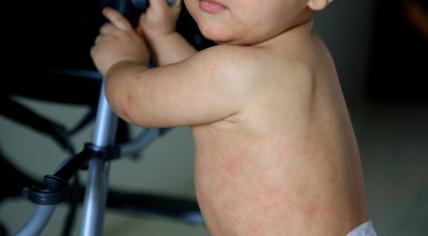
Measles outbreak hits Eindhoven schools: 14 young children & an adult infected
A measles outbreak is currently underway in Eindhoven and the surrounding area, the GGD municipal health service said on Thursday. The GGD has received reports about 14 children with an average age of 5 years old who have contracted the highly contagious disease. One adult was also infected. Three schools in the region have more than one child with measles.
The school boards and parents have been informed, but the GGD would not say which schools are involved. The health service also does not believe it is in the public interest to disclose the location of the schools. The GGD also would not say whether there is a link between the infected adult and any of the children.
"We have not been able to determine how that [first] person contracted it, but of course it must have happened somewhere. We do not have an overview about that patient," said Ronald ter Schegget, infectious diseases doctor at the GGD for the Brabant-Zuidoost region. Most cases were identified in the last ten days. Some patients are brothers or sisters of each other.
None of the patients were vaccinated, though the reason for this was not known, the health department reported. Some of them have become very ill, but they are not in mortal danger. The first infection was reported in mid-February, and many of the patients have already recovered, said Ter Schegget.
The number of infections can continue to rise, he noted. "It takes an average of about ten days before someone develops symptoms, but you can infect others before you have clear complaints yourself. You may be fine at school today, but if you get sick tomorrow, you were already contagious today."
Moreover, measles spreads very quickly. "If an infectious patient has been in a physician's waiting room, this is reason enough to include all people who were in the waiting room in the following two hours as part of the contact investigation. If you have not been vaccinated, a fleeting contact is enough."
The contagiousness can be seen in the reproduction number of the virus, which shows how quickly a virus spreads. A figure of 1.0 represents that each contagious person infects one other individual. "With the coronavirus we talked about a number of 1.5. The reproduction number of measles in unvaccinated people is 15." Hence, 100 contagious people can infect 1,500 people who have not been vaccinated.
The GGD says it does not know why the adult and children were not vaccinated. "That is a point of attention for us. The vaccination rate in Brabant-Zuidoost is better than the national average, but is declining just like in the rest of the country. This increases the risk of an outbreak. During the previous measles epidemic ten years ago we had four patients in our entire region."
"The declining vaccination rate increases the risk of spread," the GGD said. The office noted that vaccination offers good protection against the disease.
The virus that causes measles has been circulating in several other EU countries for some time. Several thousand cases had already been reported in Austria, Liechtenstein and Romania last year. The European Centre for Disease Prevention and Control recently warned that the number of infections is likely to increase.
Symptoms of measles include complaints such as fever, sneezing and coughing. Infected people usually also have inflamed eyes. After three to seven days, spots appear on the skin. "These spots first appear behind the ears and then spread over the entire body," the GGD Brabant-Zuidoost described.
Complaints often remain relatively mild, but sometimes the disease becomes very serious. "In serious cases, someone gets pneumonia or encephalitis," the National Institute for Public Health and the Environment (RIVM) explained. In exceptional cases, measles is fatal. According to the RIVM, approximately one in 10,000 cases in the Netherlands is fatal.
Unvaccinated young children, unvaccinated pregnant women and people with an immune disorder are at increased risk of becoming more seriously ill. Those people who have been identified as having contact with an infected individual will be contacted during the current GGD investigation.
The last major measles outbreak in the Netherlands was in 2013 and early 2014, when several thousand people became ill. More than 180 measles patients were admitted to a hospital, the RIVM calculated.
A 17-year-old girl died as a result of the disease. There have been only a few cases in recent years. Last year, health services registered only seven in total. That number has now already been exceeded. There were hardly any infections during the coronavirus pandemic.
The outbreak around Eindhoven already represents the highest number of infections since 2019. According to RIVM figures, 83 people in the Netherlands contracted measles that time.
Reporting by ANP
